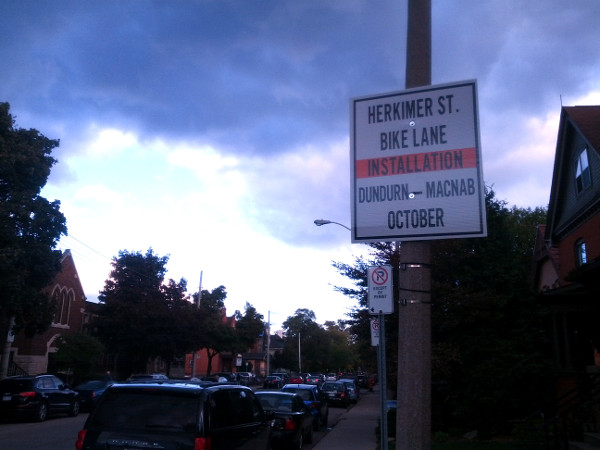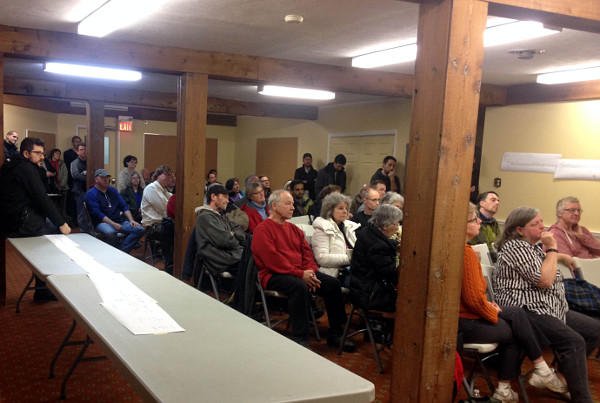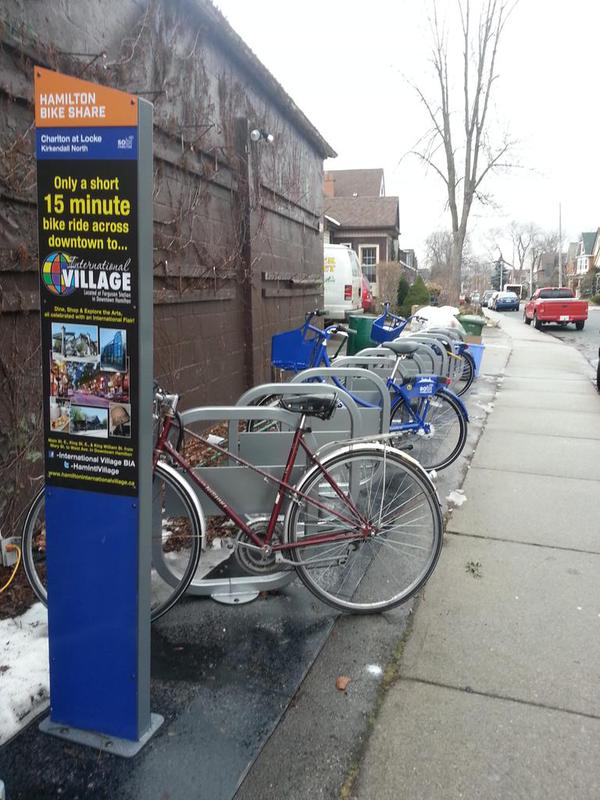This project has shown that ensuring more resident voices in the detailed design stage of cycling infrastructure planning leads to better results.
By Southwest Ad-hoc Bike Committee
Published January 29, 2016
Citizen engagement takes time, but it works and leads to better outcomes. That's the experience of members of Charlton/Herkimer Ad-Hoc Bike Committee had in working with city staff on the Charlton and Herkimer West bike lanes.
In Fall of 2014, the City posted signs informing the public that bike lanes would be installed on Herkimer and Charlton West, as recommended in Hamilton's Cycling Master Plan (adopted by City Council in 2009).

Sign in fall 2014 announcing planned bike lane installation (Image Credit: Kyle Slote)
While many residents were happy to see these lanes were finally going to be installed after so many years of delay, some residents were concerned that the proposed lanes would be fairly "pedestrian" and not meet emerging standards for safe cycling. They wanted to upgrade the bike lanes from painted lines in the "door zone" of parked cars to lanes which would be parking-protected.
Herkimer resident Kyle Slote described the reaction of many neighbours when he wrote in 2014 that the design "feels like another case of one step forward, two steps back that will undermine the cycle-ability of these streets rather than improve it."
These residents, with support from the Durand Neighbourhood Association, created the Charlton/Herkimer Ad-Hoc Bike Committee. The committee called for two major changes to the bike lanes on both Herkimer and Charlton:
Parking-protected bike lane: Install the bike lane between the curb and the parking lane, instead of between parking and the travel lane as originally proposed by the City. This type of separation of bike lanes is becoming more common in North America and offers a greater degree of comfort and protection from car traffic. Parking separated lanes are also the least costly type of separated bike lanes to install and maintain.
Make left turns from Herkimer safer by moving bike lane to left side: The Committee argued that the bike lane on Herkimer needed to be on the left/north side of the road instead of the right/south side, since almost all bike traffic ends up turning left off of Herkimer to destinations north of the street (due to the presence of the escarpment, there are few destinations south of Herkimer).
With a bike lane located on the left/north side of Herkimer, it would be much safer and easier for bikes to turn left, than if the lane was on the right/south side.
Ward 2 Councillor Jason Farr was very supportive of this vision for higher quality bike lanes and encouraged staff to engage with residents to improve the design. Then-Ward 1 Councillor Brian McHattie was running for Mayor, so while supportive, he was not directly involved. Current Ward 1 Councillor Aidan Johnson has been supportive as well.
The preliminary re-design for the bike lanes received positive feedback at a Ward 2 Town Hall in early 2015. Councillor Farr's support and city staff's openness to changing the overall design was welcomed by Charlton/Herkimer Ad-Hoc Bike Committee members.
The city's final design incorporates the resident feedback and is a great improvement from the original design.
That design was presented by staff at a January 28 Public Meeting organized by Councillor Johnson. More than 50 residents attended the meeting, and there was broad and strong support for this design, with only three residents making negative comments.

Attendees at the January 28, 2016 public meeting at Stanley Avenue Baptist Church
The Committee argued that Herkimer and Charlton are perfect locations for Hamilton's first parking-protected bike lanes. There are already a large number of commuter cyclists who use these streets, so adding these protected bike lanes will increase their safety.
The extra protection of these lanes will be especially important to inspire new cyclists including seniors and families with children to cycle to nearby destinations. A 2014 poll found that 67 percent of Ontario residents would cycle more often if there was better cycling infrastructure.
Herkimer and Charlton West serve a very high number of destinations, and these high quality bike lanes will help further encourage cycling as a mode of transportation for short trips to these destinations. Destinations directly served by these bike lanes include:
The presence of numerous Bike Share hubs is another factor pointing to the need for high quality bike lanes on Charlton and Herkimer.
Hamilton Bike Share has been instrumental in re-introducing cycling as an everyday activity for thousands of Hamiltonians, but a common complaint they receive is that new riders wish there were more safe places to ride in Hamilton.

Bike share station at Charlton and Locke (RTH file photo)
The street calming provided by bike lanes will benefit residents who don't ride a bicycle but walk or live on these streets. The bike lanes will reduce travel lanes that are currently around 3.5 to 4.5 metres (11-15 feet) wide to closer to 3 metres (10 feet) wide in most places, which will reduce the incidence of speeding while still allowing the current volume of cars to flow on these streets.
There is growing evidence that narrower travel lanes are safer for pedestrians, cyclists and drivers. The City of Toronto now aims to have travel lanes on minor arterial roads (which is the classification for Herkimer and Charlton West) to be 3 metres wide (with a minimum of 2.8 metres (9 feet) and a maximum of 3.3 (11 feet) metres where necessary).
The City of Toronto's updated Vehicle Travel Lane Width Guidelines [PDF] note:
Historically, passenger vehicles were understood to be the principal mode of transportation on Toronto's roadways. As a result, wider vehicle travel lanes were often favoured to create a more forgiving and comfortable environment for drivers. Today, Toronto's streets and roadways are significantly more heterogeneous. Lane widths must now balance the safety, access, and comfort for all users, including pedestrians, cyclists, transit riders, and drivers.
The National Association of City Transportation Officials (NACTO) guidelines about lane widths states:
Lane widths of 10 feet (3.05m) are appropriate in urban areas and have a positive impact on a street's safety without impacting traffic operations. [...] Research has shown that narrower lane widths can effectively manage speeds without decreasing safety, and that wider lanes do not correlate to safer streets. Moreover, wider travel lanes also increase exposure and crossing distance for pedestrians at intersections and midblock crossings.
Even with the evidence that narrower lanes are safer, these narrow widths will be an adjustment for drivers and residents on these streets. In particular, city staff are already planning operational adjustments to garbage pickup, street cleaning and snow clearing to accommodate these activities in the more limited space.
City staff have indicated that the Charlton/Herkimer bike lanes will be installed in early Spring 2016. Charlton/Herkimer Ad-Hoc Bike Committee members have been dismayed that the timeline for installation of these bike lanes is continuing to be stretched to about 18 months after the initially designed lanes were planned to be installed (Fall 2014), and six years after their approval by Council.
The delays to the finalization of these bike lanes can be attributed in part to the fact that there is only one city staff person responsible for all cycling projects across the city and that special projects like Pan American Games diverted staff time from regular cycling projects like this one.
A city the size of Hamilton needs more staff dedicated to cycling infrastructure.
The one benefit from longer timelines is that there have been a few more opportunities for resident engagement than has been the case for most other cycling projects in Hamilton. Charlton/Herkimer Ad-Hoc Bike Committee members have been pleased to see that each round of design changes by city staff reflected community feedback and many major and minor details suggested by residents have been incorporated into the final design.
This project has shown that ensuring more resident voices in the detailed design stage of cycling infrastructure planning leads to better results. The city must continue to increase its engagement with residents in all parts of the city who want improved cycling infrastructure to get their feedback on what would be the best design for their neighbourhoods.
By ergopepsi (registered) | Posted January 29, 2016 at 10:14:13
I was a bit disappointed to see that the stretch between Dundurn and Locke won't be parking protected but very happy that it is a done deal. Looking forward to spring!
Also I noticed at the meeting that most of the detractors were elderly people who I don't think were able to see the bigger picture of this kind of development. Brings to mind a comment made by Burlington mayor Goldring regarding their planned 300 million dollar expenditure on roads, transit and bike paths - "If you look at not growing, what you'll see is a population that will age." If don't keep pushing forward on these complete streets young people will not want to move here. We'll end up a city full of pensioners on fixed incomes.
By fmurray (registered) | Posted January 29, 2016 at 15:18:08 in reply to Comment 116266
I noticed that many of the supporters were elderly as well! Whether they are just looking forward to traffic-calming or are cyclists themselves, there were many comments from people who may have had questions, but were ultimately supportive of the plan.
By kdslote (registered) | Posted January 29, 2016 at 10:14:29
It has been a long but encouraging process! Very grateful for this committee and the work done by everyone involved. These lanes won't be perfect, but they are light years better than the initial city design - and there will be opportunities for future tweaking and improving. Can't wait to see these installed!
By JasonL (registered) | Posted January 29, 2016 at 11:22:17 in reply to Comment 116267
agreed. And this is yet another new form of bike lanes coming to Hamilton for the first time: parking-protected. It's been a long uphill slog, but in the past few years we've seen our first 2-way cycle tracks, first green bike boxes, first curb/knockdown stick protected cycle track and now first parking protected bike lanes. This is setting us up nicely for future projects by having city hall develop the expertise and skill to plan and install these types of facilities.
By JasonL (registered) | Posted January 29, 2016 at 13:47:24
Bit of inspiration from another car-worshipping, even colder city than us:
By brendansimons (registered) | Posted January 29, 2016 at 15:21:13
"That design was presented by staff at a January 28 Public Meeting organized by Councillor Johnson. "
Can someone post a link to the final design? It's not in the linked article, and there's nothing on the city's cycling page other than a line saying the project is "in the works".
By KevinLove (registered) | Posted January 29, 2016 at 16:36:28 in reply to Comment 116271
There is no link to the final design. Nor will there be. It is the policy of the City of Hamilton to not make this information public on the internet.
If you wish this policy to change, I suggest contacting your municipal councillor.
Comment edited by KevinLove on 2016-01-29 16:37:07
By IanReynolds (registered) | Posted January 29, 2016 at 16:10:30
Those are great improvements. I noticed those signs on Charlton a long, long time ago, and they helped me realize the speed at which the city moves to enact changes.
I'm so glad these lanes are finally going to happen.
By Vincent (anonymous) | Posted January 29, 2016 at 17:54:26
Great news, hopefully this will help to open the floodgates, especially for neighbourhoods who might not have such strong community voices.
By adam (anonymous) | Posted January 30, 2016 at 10:13:00
Wish I could have been there:
- What was the rationale for not having parking protected bike lanes between Locke and Dundurn? (A real missed opportunity for safety, cycling continuity, bus alignment, and no parking enforcement issues)?
By ergopepsi (registered) | Posted January 30, 2016 at 20:42:29 in reply to Comment 116276
They wouldn't be able to fit a snowplow was one reason.
By kdslote (registered) | Posted February 01, 2016 at 12:03:33 in reply to Comment 116281
They said there wasn't enough width to have parking protected + a dooring buffer on this stretch (meaning cyclists would have nowhere to go if someone opened a door). Snowplowing was also cited as an issue because the parked cars would be too close to the plow's blade, creating a possibility for damage to the cars/plow.
By chirpy (anonymous) | Posted May 29, 2016 at 12:42:45
I attended the meeting and was not surprised that a few car lovers felt the bike lanes and lower speed limit would cramp their accustomed driving habit. They are the very speeders who race through east west streets to get to work, using them as their personal super highway! The reality is that these streets, especially Charlton, are mostly residential, have schools, daycare facilities, churches, seniors' homes and facilities for the disabled. The number of buses, trucks and autos has increased over the years and so have the speeds. The noise and rough road surface also contribute to a very "uncalm" setting for adult residents and their families. Recently the repaving of a few sections of road has made a huge difference in the vibrations felt in homes whenever a truck or bus zooms by. The lower 40km speed limit does make some difference too but there are still drivers who speed, so will it ever be enforced? Hopefully the bike lanes will help calm traffic even more and serve as a buffer to the traffic noise for North side residents who cannot park on their side anymore. The parking side rarely gets swept, tickets are handed out if a car is parked on the day reserved for sweeping. This would be fair if residents were informed of a set day per month when sweeping took place but as far as I know, there is no longer a set day as there is for many sidestreets nearer to downtown. In that case, the residents know their cars must not be parked on a certain side BUT they can be parked on the opposite side. On Charlton the residents have no option to park on the opposite side, the North side which will soon have bike lanes installed. All in all, the residents I have spoken to think the recent changes will be an improvement over the status quo. I too am optimistic especially with bike lane installations coming soon!
It's hard to please everyone but pedestrians and home owners should not feel unsafe walking on sidewalks along sidestreets or simply doing maintenance, sweeping walkways etc. in front of their homes. The excessive speeding has become chronic and now at least there are some attempts to lessen the problem. Over the years many drivers have come to know that they can get away with speeding on the side streets but now residents are protesting and thankfully the City is listening. In Toronto, drivers have tried to use sidestreets as shortcuts and there was a huge reaction by residents. The City took action and the calming was restored. Let's hope the beautiful east west streets in Hamilton are preserved as more safe, quiet, clean and pedestrian friendly.
You must be logged in to comment.
There are no upcoming events right now.
Why not post one?